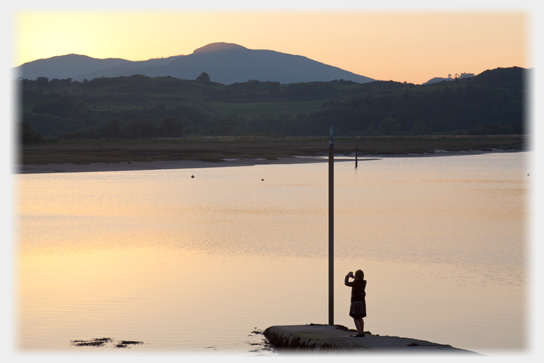
|
Photographer's Haul
'Catching' the sunset, taking a picture, even bagging a photo, we return from the fair ground of experience, our treasured goldfish secure. We have swag in our bag. More elegantly: "To photograph is to appropriate the thing photographed...Photographed images do not seem to be statements about the world so much as pieces of it." (Sontag, 1977) So writes Susan Sontag, in one of her delightful essays on photography, marking at once the interplay between the physical and mental objects of photography: the piece of the world and the conceptual ramifications it elicits. These pieces become greatly treasured personal collections: of families, of bodies, of journeys.
Those are common ends for the pictures we gather, although not the only ones, and a notable feature of the process of collecting is the wish of the photographer and collector to aestheticize such objects or collections. So the picture here is archetypal of its genre, however, the desire for beauty is not the only hallmark of our habit, there is a far more personal one which can be seen clearly in the family album. Where "...ghostly traces, photographs, supply the token presence of the dispersed relatives. A family's photograph album is generally about the extended family—and, often, is all that remains of it." (Sontag, 1977) We attempt to 'catch' and to hold friends and relatives in scrapbooks and folders just because they are fleeing from us.
The theme of catching and more literally holding, arises again in a very different kind of collection. Far from the presentation of virtuous order shown in family groups, photographs (and photographs' decedents in film and the internet) have proved most welcome to our salacious selves. In these images it is not the memory of particular people that is caught, but an abstracted desirable form. The persona of a fashionable unobtainable idol, a body from the world of fashion or on display––the body we cannot know, or that could be anyone; these we purloin for those most private of purposes. And these collections, not only for teenagers, are dear to many hearts.
The third pillar to the edifice of our photographic collections is far from private. We explicitly snap what we see when travelling in order to show other people. The growth in photography has been exactly matched by the growth in mass tourism. We visit places novel to us and collect samples into our small black boxes to return, so often vainly, anticipating examination of our specimens with our friends. We seek out townscapes, we seek out landscapes, we seek out novelty, we seek out nature benign and nature raw, to add to our collections. We travel with our cameras for the afternoon, the weekend, or round the world, clicking away - and so tourism, from early days, made the fortunes of photographic manufacturers.
While sunsets like the one above stay relatively constant in this pantheon, other aspects of nature do not. As the extended family is in jeopardy in much of the world, so also is nature. Again Sontag remarks succinctly: "...because nature has ceased to be what it always had been—what people needed protection from. Now nature—tamed, endangered, mortal—needs to be protected from people. When we are afraid, we shoot, But when we are nostalgic, we take pictures." (Sontag, 1977) Today our trophies are those slim objects.
Whichever way we turn, whether it be to the place visited, or a corner of nature, or our families as they were, or the delight of a "...quivering thigh, And the demesnes [territory] that there adjacent lie," (Romeo & Juliet) we want to preserve, we want to stay connected. Like Rabindranath Tagore's four year old daughter on his departure, our collections emphatically re-echo her cry "I won't let you go." (Dyson) These collections of physical objects are so dear to us because they can conjure our past. The objects in the collections, while physical and without meaning to others, are massively meaningful to ourselves; building bridges to endangered realms. The collections form a key; a key that unleashes memory.
References
- Dyson, Ketaki Kushari (1992, translation) 'Rabindranath Tagore - I Won't Let You Go' UBS Publishers, New Delhi. From Rabindranath Tagore's 'Sonar Tari' (1894).
- Sontag, Susan (1977) 'On Photography' Farrar, Straus and Giroux. New York.
15th September 2015 ~ 28th September 2015